Japanese room dividers are pieces created using traditional Japanese handcrafting techniques. It can separate a room into multiple parts or work as a decorative accent. Since its tasteful furniture with various functions, you need to pick the perfect one for your needs. Here are 11 ways to incorporate this beautiful furniture into your interior design.
Jump to:
- What is a Japanese Room Divider?
- Open-and-close partitions for more privacy
- Separate Kitchen and Dining area
- As an art collection
- As a semi-partition screen at the doorway
- To partition a changing area
- To sit in front of a large window
- Recreate a guest room instantly
- To make your space look more visually interesting
- As a temporary display
- To screen outdoor areas
- Increase the relaxed ambience of the place
- Hide unsightly parts of the house
- Conclusion
What is a Japanese Room Divider?
Japanese room dividers are folding screens that act as room dividers to provide privacy and diffuse light throughout the room. The construction typically comprises a wood frame that artisans fill in with paper, wicker, or cloth.
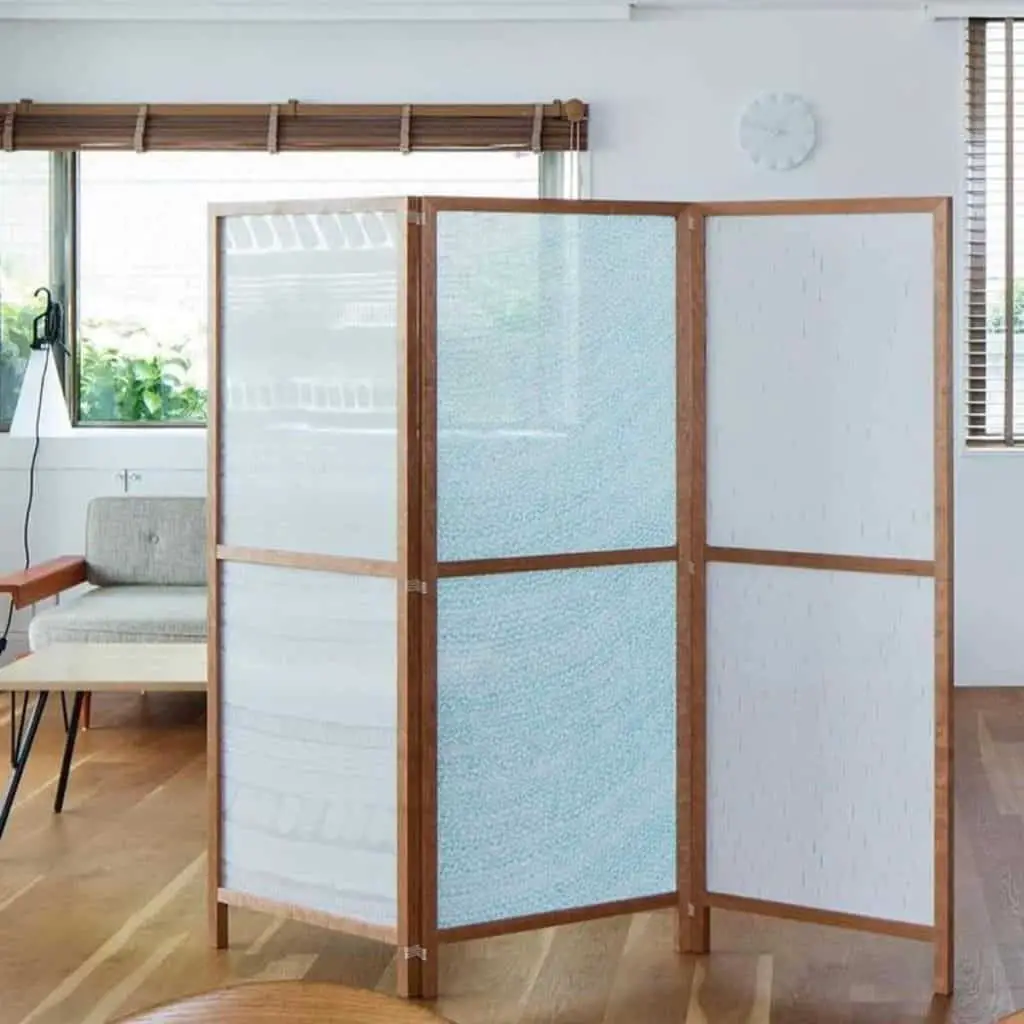
The difference with Shoji screens
The main difference between a Japanese room divider and shoji screen is that the latter is also used to refer to permanent structures made of paper screens. For example, shoji doors and windows which feature the same construction as a door or window. Another thing to note is that traditionally, the Japanese use shoji screens as decorative translucent displays that depict legends and history.
However, most people will call Japanese room dividers "shoji screens".
The Japanese originally made the shoji screens by applying many layers of paper in a specific sequence through a technique known as karibari. Some people refer to shoji screens as rice paper door panels, rice paper screens, or Japanese rice paper doors.

The Japanese adapted the shoji screen from Chinese folding screens created hundreds of years before 400 B.C. Since then, the shoji screen has travelled across many countries and its design adapted to fit diverse cultures.
Shoji Blinds
Modern-day Japanese room dividers are sometimes known as ‘shoji blinds’. Shoji blinds are partition wall that divides different areas within Japanese homes. They are not always translucent and opaque materials usually make up their main material.
If you have acquired one of these useful and beautiful shoji blinds and would like to know where to place them, check out the 11 ideas below.
Open-and-close partitions for more privacy
These 4-panel Japanese room dividers are ideal for situations where you want to simply and quickly transition between sectioning off and opening up your space. You can hinge together three, four, or more panels that may be translucent (Japanese shoji) or opaque (fusuma).

A solid partition wall or frosted glass panels, or perhaps sliding doors will offer the seclusion you need. Solid partitions are not visible from the outside and vice versa, so unlike a clear glass partition, you cannot see through.
With folding screens, you can achieve a high level of privacy. They are simple, lightweight, and attractive partitions. If you have a small space and need to adjust your area often, it is an excellent choice for discretion and optimising privacy. In addition, if you share the space with others, it will be a noise barrier that allows you to concentrate.
- Rice Paper and Spruce Wood: Our folding screen features fiber-reinforced rice paper that provides privacy without blocking light. The durable Scandanavian Spruce frame ensures long-lasting performance and is light enough to move and store easily.
- Convenient Small Size: This short partition is a breeze to set up. Use on a desktop or wildowsill, or hide clutter, laundry, dog crates, cat litter boxes, and other eyesores. Lightweight folding design is easy to fold up and store away.
- Modern Japanese Design: This sleek and minimalist partition is blends traditional craftsmanship and contemporary style. The front features a traditional wooden Shoji lattice while the back is simple, unadorned rice paper.
- Flexible Double-Hinged Panels: Premium two-way reversible hinges allow the panels to bend in either direction so you can create the perfect configuration to suit your needs. It's a versatile and user-friendly solution for customizing your space.
- Light and airy: Translucent washi rice paper provides privacy without blocking out light and sound so you can create your own breezy, sun-dappled private sanctuary.
Separate Kitchen and Dining area
Another take on Japanese room dividers is to take a leaf from the photo above and use them to screen off your dining area. When you keep the wood frame colours consistent with the rest of your furniture, you can achieve a seamless line that does not seem out of place with the entire house. The doors slide to close off the surrounding areas.

One aesthetic advantage of this method is that you can use these sliding Japanese room dividers almost everywhere. You can try this method for those who live in studio apartments and need to screen off the kitchen and dining areas. It helps to minimise the intense odours and oily fumes when cooking.
As an art collection
If you want a unique way to display artwork, you can follow the example above and invest in stunning oriental Japanese room dividers that you can frame on the walls. Put the panels up on essential rooms such as office meeting rooms if you do.
This way of displaying the screen panels has a historical origin. It’s known as byobu (屏風) which wind wall in Japanese. In the past Samurai era of Japan, it describes how the wealthy merchant classes used to display such artwork. These beautiful paintings usually had backgrounds of gold leaves and colourful scenes of nature and daily life. When you see a byobu in a house, it conveys the owner’s high rank, wealth, and power.
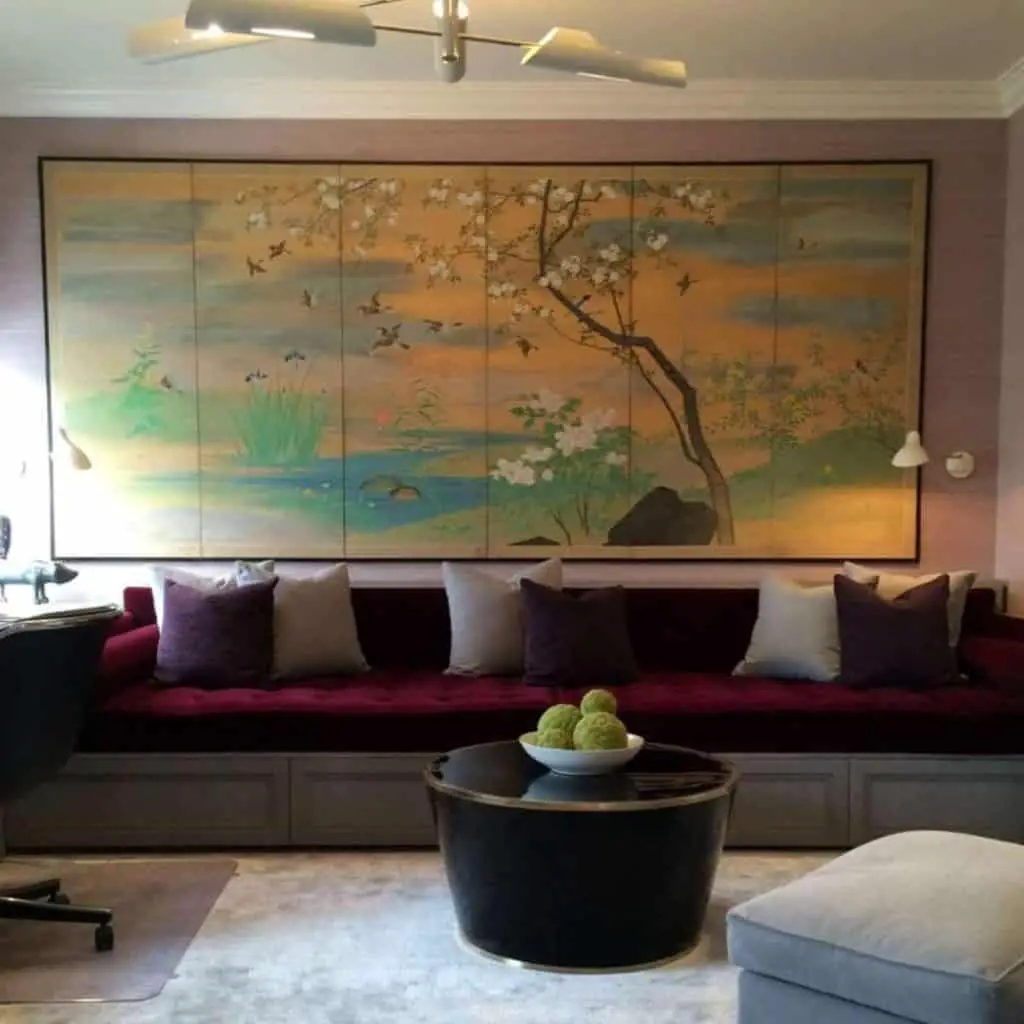
These days, the term refers to elegant panels that can go on the wall. Artwork on Japanese shoji screens typically starts at the bottom of the screen. It is done in this way because it is customary for people to sit on the floor in Japanese culture.
They centre the design on the bottom of the screen to be at eye level. Because of this, it is a perfect way to introduce some art appreciation while one is seated in the office meeting room, living room or dining area.
- Beautiful handpainted japanese art, sumi-e ink on handcrafted gold leaf wall screens
- Fine silk brocade matte border, easy mount hardware, hinged for table top display
- 3 sizes, remakable works of hand painted art for the less than a comparable print
- Browse our extraordinary selection of asian art and 2000+ asian home décor and unique gifts
- Designed specifically for Japanese screens or byobu
- Made in USA
- Powder-coated with satin black finish
As a semi-partition screen at the doorway

Like the photo above, you can use a Japanese room divider to partition the entryway.
The local artisans in Japan call these types of panels, "fusuma". You might notice an opaque panel set in a wooden stand.
Usually seen in traditional style Japanese mansions, they have dual functions. They help section the entrance and also control the amount of wind or sunlight that floods the room. This technique originated during the Heian period from the mansions of the noble classes.
Using fusama panels, you can show your guests where you’ll like them to take off their shoes. Put one in front of the doorway with a small wooden bench. The guests can sit there and remove their shoes.
It is an Asian custom to leave your shoes at the entrance before entering the house as a sign of respect for the owners. If you purchase one with beautiful artwork, it also makes an aesthetically pleasing entrance for your guests.
To partition a changing area
If your bedroom does not have a lot of space, but you want to create privacy for changing, you can incorporate the example above into your real-life interior concept. A Japanese room divider works well to partition a room and provide privacy. The choice of material affects how wind flows in the room, too.

The picture above shows a divide made with rice paper like panels set in a solid wood frame. This construction acts as thermal insulation, protecting from the cold in winter and reducing heat in the summer.
The divider’s paper and wood material absorbs less heat and releases moisture when the room is too dry. As a result, putting one in your room helps lessen the effect of using an air conditioner or when days are too cold.
To sit in front of a large window
For those who live on the ground level and have friendly neighbours, you might want to keep part of your family life private while appearing welcoming. A Japanese room divider can be set in front of a large window and keep your life hidden from prying eyes. It is less offensive than putting on heavy curtains and keeps up a level of openness.
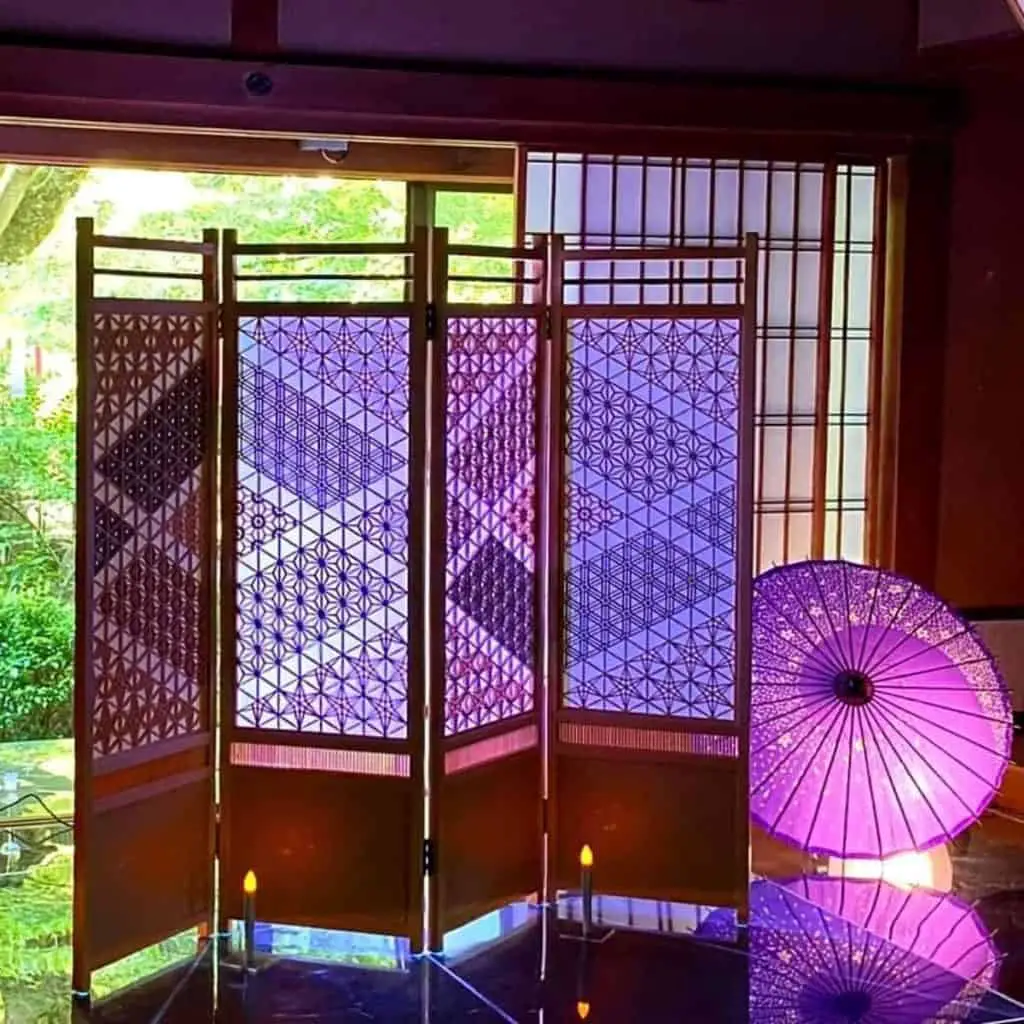
These opaque frames are lightweight, so you can take them away and store them when it gets dark. Another advantage is that it also helps to screen off bright afternoon sunlight. The aesthetic benefit of shoji dividers is that they are not a sharp barrier between the outside and the inside since we cannot lock them like doors.
If you choose a translucent screen, you can still appreciate the beautiful sway of the trees. An opaque one like the picture above allows air to diffuse through and some light into the house. It is a thoughtful reminder for both people who are outside and within the barrier to speak and move calmly with respect for others.
- Hand Crafted with Fir Wood and particle board
- Weight: Approximately 35 lbs
- Size: 6 Feet Tall x 6.67 Feet Wide
- RETAIL VALUE OF $289.99
- Please notice, the back side of the room divider does not have decoration. It stains as the front frame color
Recreate a guest room instantly
If you often have guests over unannounced or like to gather your friends for dinner, then a Japanese room divider would be helpful. You can use it to transform your space without spending too much money.
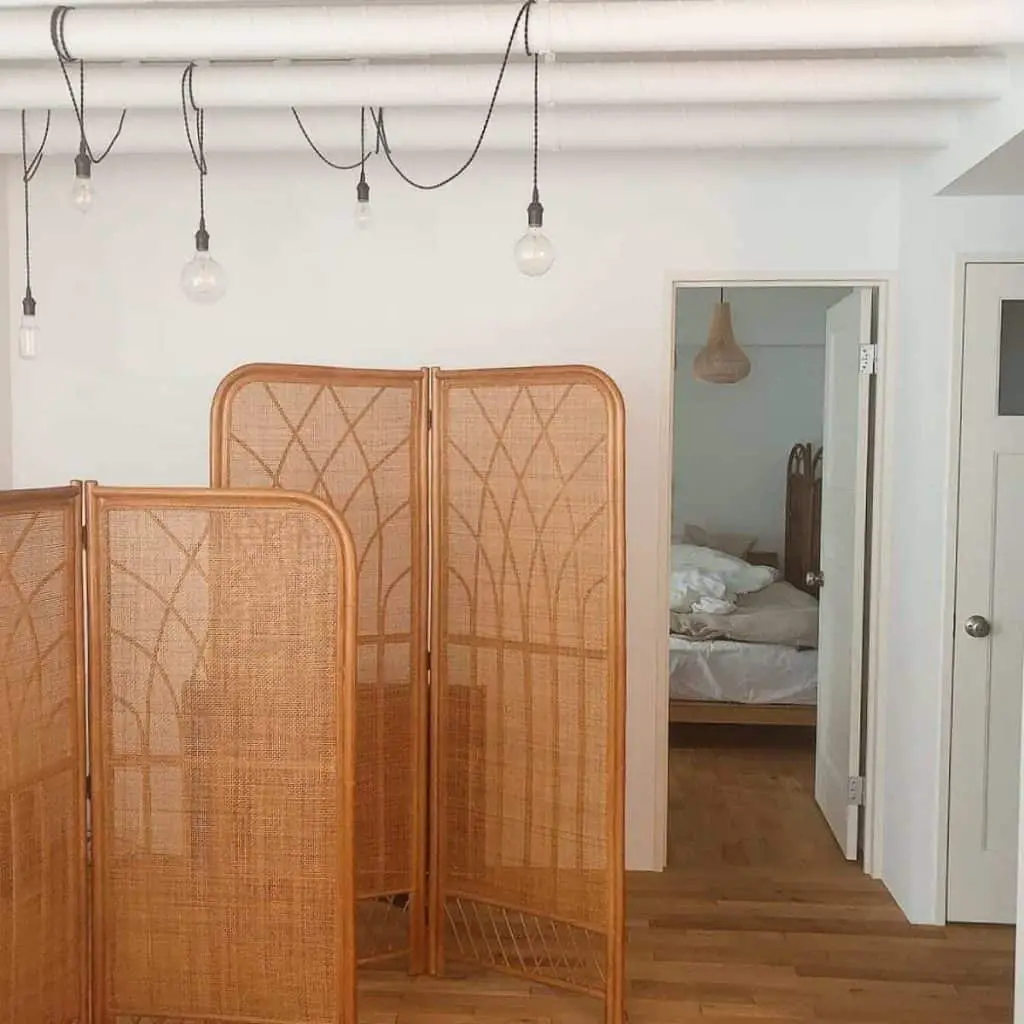
Since they are portable and light, you can keep them in a closet when not in use or take them to screen off areas when you are hosting guests. You can throw together quickly the room for social gatherings, like in the photo above.
You can choose translucent panels like those above to have some design on them. When it’s translucent, it allows some light to flow through. This design gives an uninterrupted sense of ease when travelling from the partitioned area back to the main living room. If you want to restrict the site clearly, use a colour that contrasts your main furniture. It will also show off your panel designs better.
- ROOM DIVIDER SCREEN (6-PANEL, ESPRESSO RUST) — This partition style screen divides your room for privacy or simply to display as a decorative accent
- CREATES PRIVACY — Suitable for dressing privacy, porch privacy, privacy from neighbors on patio — Covers windows, blocks off unsightly items, divides sleeping areas for guests
- VERSATILE USE — Ideal sunscreen, home decor, partition furniture, decor screen panels, patient divider for clinics — Makes room distinctions without real walls — Adds intrigue and defines space in studio apartment, living room, bedroom, kids room, sunroom, laundry area, backyard patio, and more — Complements bohemian, modern, traditional, rustic farmhouse styles
- FOLDABLE PANELS — No assembly required — 2-way hinges allow for folding in either direction and provides arrangement flexibility — Simply slide the two shelves into the divider and expand to the length of your preference — Lightweight and easy to move — Folds close for storage when not in use
- DECORATIVE DESIGN — Stylish diamond weave pattern in brown/orange/beige— Made of Russian camphor pine and paper rope — Includes 4,6,8 panels — Double-hinged for versatility and folding — Protect from outdoor elements — Each panel approx. 19.50” wide — Overall unit measures approximately 96” L x 19.50” W x 69” H
To make your space look more visually interesting
You might not need to screen off any areas, but you want to make your space look more exciting. A Japanese room divider can help enhance the house's beauty and decorate your walls without extensive renovation. For example, you can purchase a panel with vertical running timber and nature scenes to provide a peaceful ambience to the house.
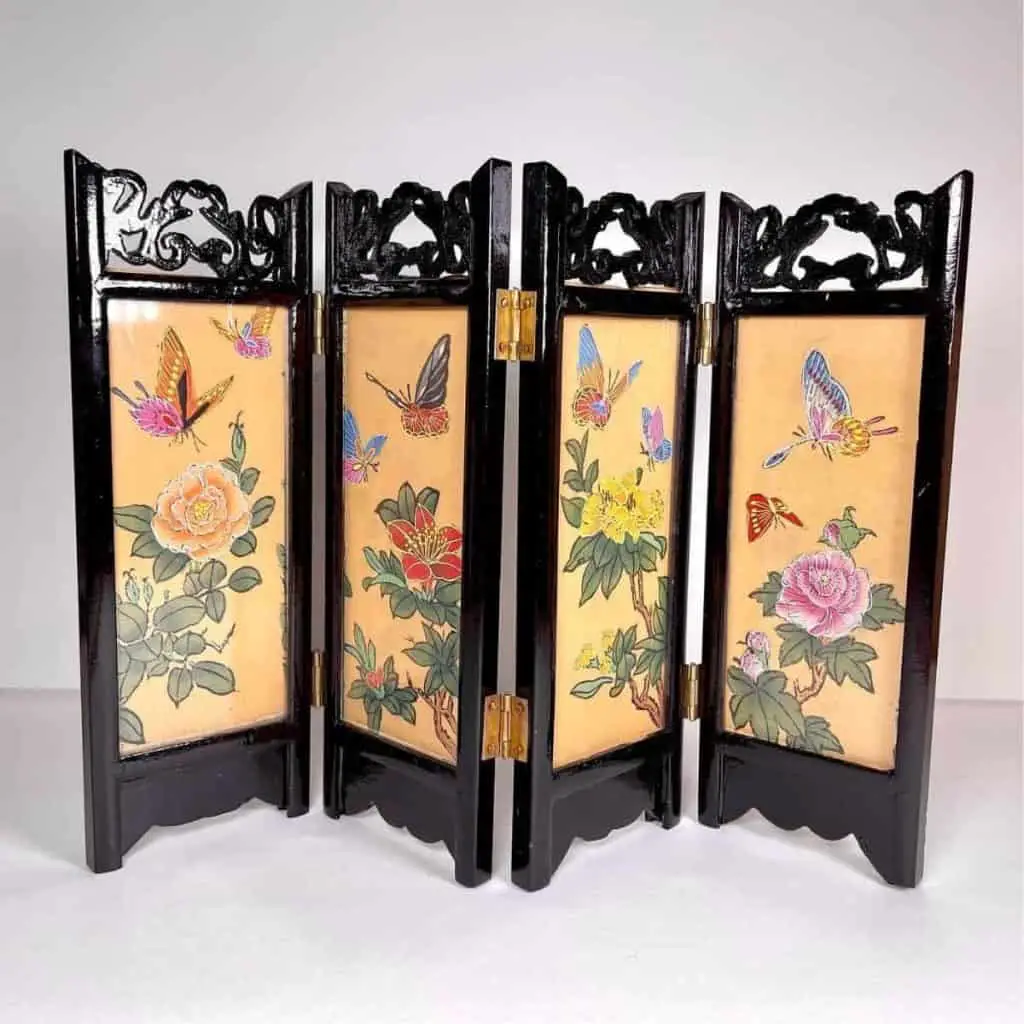
The Japanese interior rarely has wall decorations. The walls are meant as a neutral background for the rest of the furniture. Therefore, you might see Japanese houses with partitions painted with luxurious designs.
Such a practice was commonplace in China and other parts of Asia too. So, you will find that the designs for room dividers will differ from one region to the next. However, a popular art style applied to such pieces was focused on nature.
It’s both a functional and aesthetic benefit, so you can put a temporary visual focus in your space and remove it when you tire of it. Additionally, a Japanese room divider is very affordable if you purchase them from Amazon, minimising the redecoration cost.
- Beautiful handpainted watercolors and ink handcrafted silk screens, sung, ming, sumi-e wall art
- Fine silk brocade matte border, easy mount hardware, hinged for table top display
- 3 sizes to choose, 3ft. by 1.5ft., 4ft. by 2ft., 6ft. by 3ft., remakable work of handpainted art
- Browse our huge selection of japanese, chinese, asian décor, room dividers, art, lamps and gifts
As a temporary display
The Japanese minimalism concept is all about multi-tasking pieces of furniture, so a Japanese room divider is also part of this idea. For example, the panels can act as shelves for your favourite items. Choose a solid wood frame for a sturdy display. The rustic design can also be folded and tucked away when not in use.
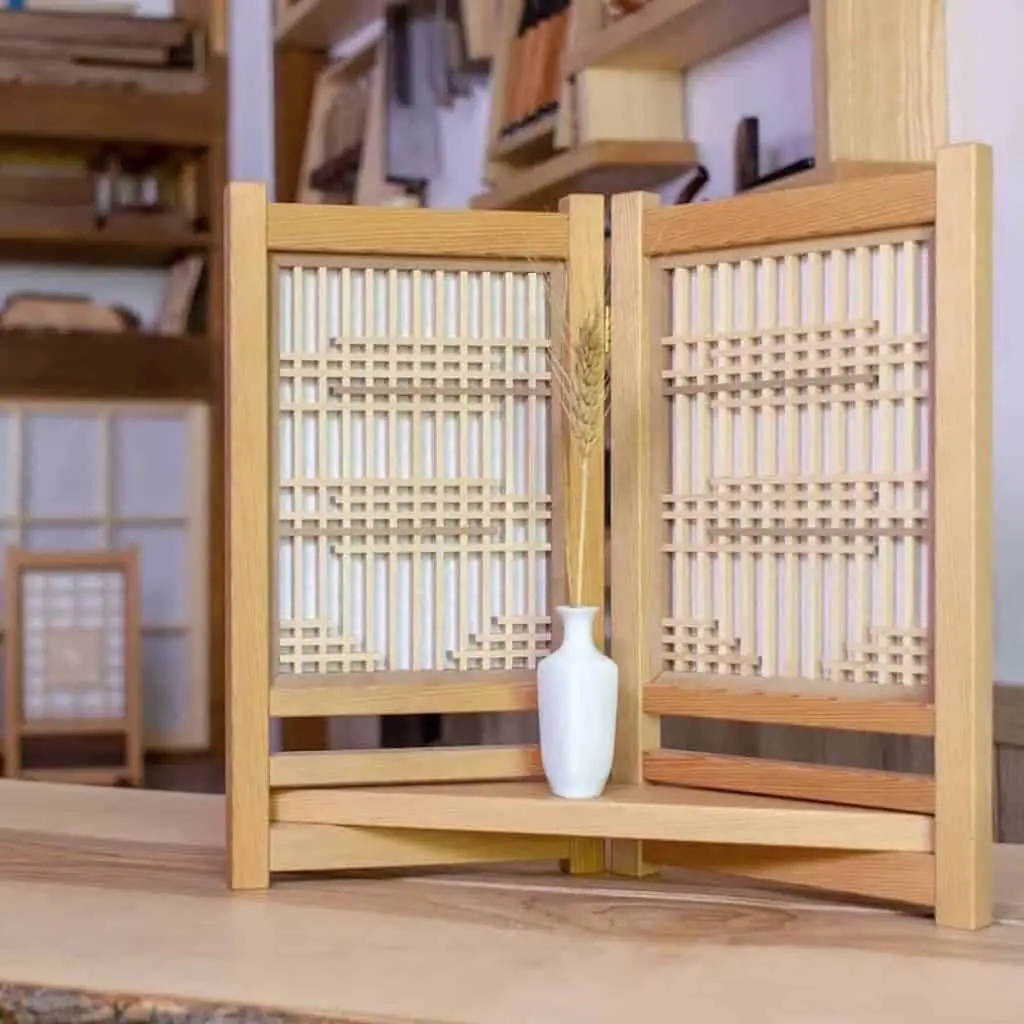
The advantage of using such free-standing panel screens is that you can always move them elsewhere. Also, the partition is above ground, allowing air to circulate in the house from the floor up. The effect creates a clean, symmetrical effect, giving the space order and calm.
No products found.
To screen outdoor areas
For those who live in an open courtyard, you want to appreciate nature without bringing insects into the house. You can place a Japanese room divider between the courtyard and the living room areas. Since the room is elevated on a dark wooden deck, the open living room contrasts the light-coloured panels and ceilings above.

By designing the house this way, consider wind conditions to know where to place the openings. Since panels can direct the flow of wind in the house, by placing these portable screens, you can allow good airflow while still enjoying some privacy. Once you have closed off the screens, you can also protect yourself from insects outside.
Increase the relaxed ambience of the place
While using a Japanese room divider is an idea that came from Japan, they are borrowed from the Oriental panels that exist in China. This global influence also means that the panels are available in other countries, with the locals adapting them to suit their own nuanced aesthetics. One such example is Bali in Indonesia, known for its wooden screen panels in its resorts to provide a gentle touch of relaxation.
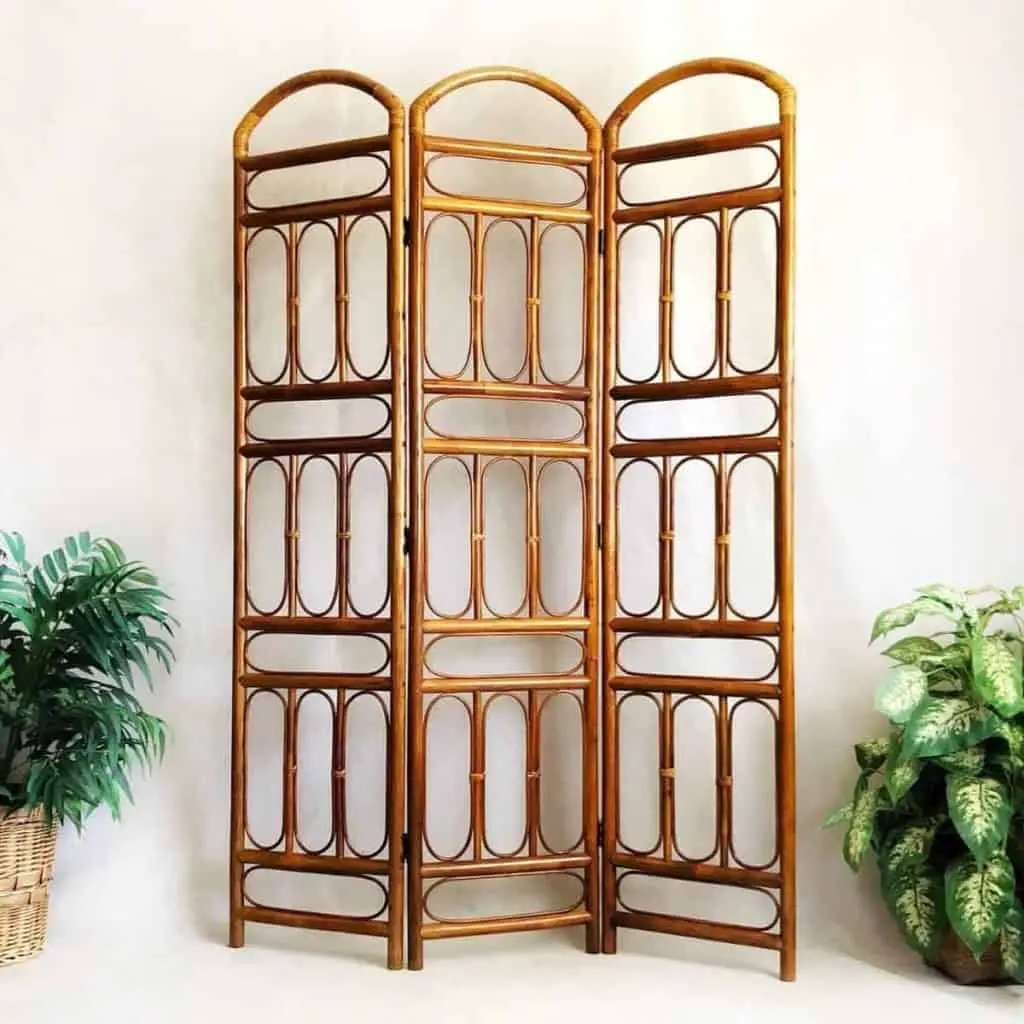
The critical difference is that Japanese screen panels made in Indonesia usually feature light wood in a lattice pattern with wide openings in between. There are many designs, with some panels purely made of bamboo or rattan even.
This design emphasises a connection between the indoors and outdoors. So even in an urban space, you will remember the need to relax. Borrowed largely from Bali's influence, it gives a refined look to the place while still keeping that groundedness with nature.
- Screen has three panels with size of 52.40"W x 0.80"D x 70"H. Easy to move when folded.
- Folded is 17.4"W x 2.3"D x 70"H. Each screen panel is 17.48"W.
- Made of solid wood frame and plywood panels in Walnut finish.
- Wood 3 Panel Screen
- Great Room Divider
Hide unsightly parts of the house
A small space often means nowhere to conceal everyday chores in your life, such as the pile of unwashed laundry or your freezer. Many people also like to hide their washer and dryer, as it does not blend well with the house's interior. A Japanese room divider comes in very handy to hide these. The example above actually hides a washer and dryer in the kitchen.
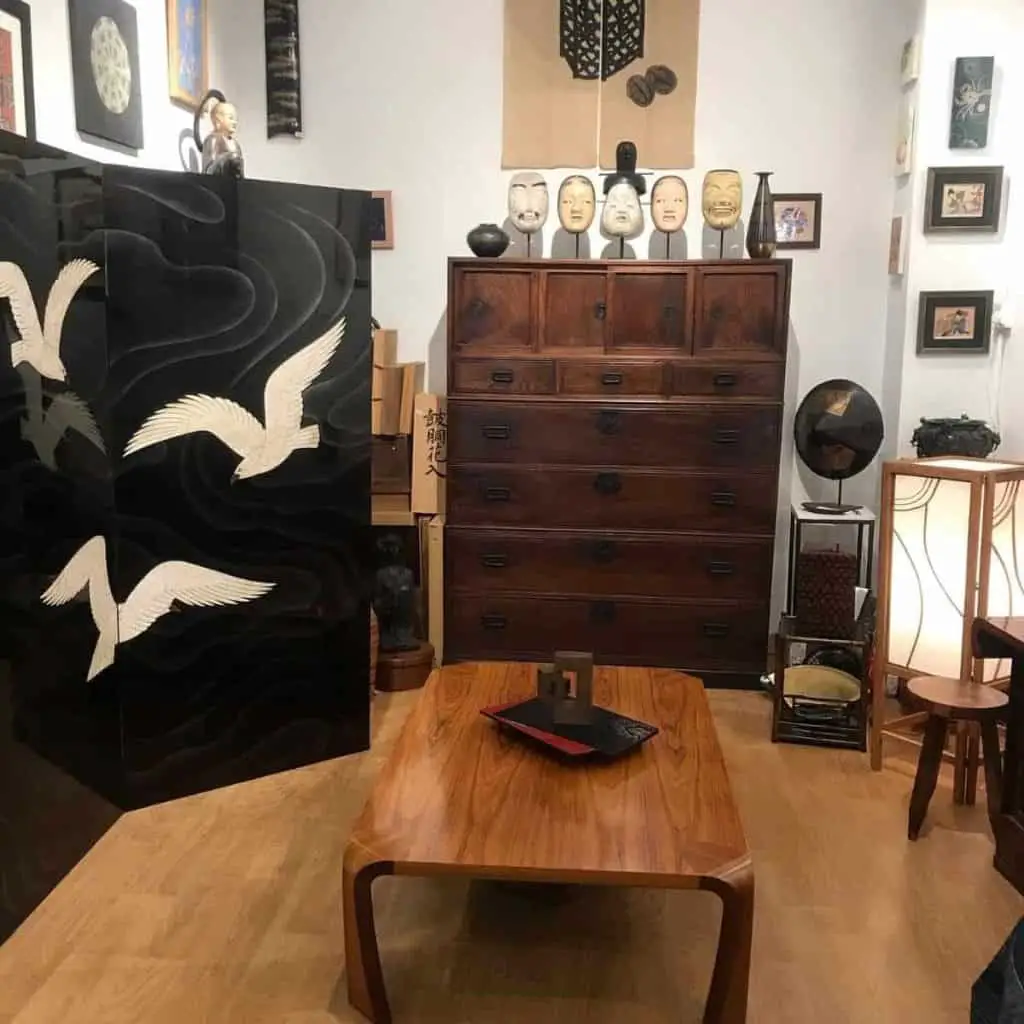
The obvious aesthetic advantage is that it keeps your space from looking like an eyesore and hides the untidiness that you do not want your guests to see. You can easily remove it, so you can keep the screens to one side when you are ready to do your laundry.
- 3 Panels measures 70” High X 51” Wide Black color nice smooth finish
- Nice Looking: Designed to look equally attractive from front or back. Perfect space privacy separation
- Sturdy design. Made out of high-quality Solid rubber wood frame with plywood insert
- Easily folds flat for storage on six 2-way hinges
- Ready to use instantly. Easy to move. Assembled
Conclusion
A Japanese room divider serves many purposes, as you can see from the examples above. They have also evolved to become contemporary artworks, with modern artists outdoing themselves to recreate nature scenes for display in a house. You have many options to select when you want to purchase partitions.
We hope you have enjoyed these ideas and are inspired to use them in your own homes. If you want more interior design inspiration, follow us on Pinterest at @honesthometalks!










